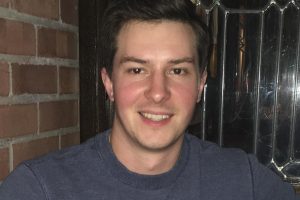
Sam Schaffter missed the dawn of the computer age, but he’s reliving the crux of the experience—the use of simple logic structure to build complicated programs—in the lab, where he coaxes DNA nanotubes toward the long-term goal of self-healing.
The second-year graduate student entered the ChemBE PhD program in 2015 after earning bachelor’s degrees in biochemistry and bioengineering at Purdue. Interested in computers, chemical reactions, and biological materials, he immediately recognized nanostructure systems as the perfect fit for him, blending all his passions. The National Science Foundation agreed, awarding him an NSF fellowship that gives him a stipend and opportunities for international research and professional development.
The beauty of self-assembling nanostructures—or any structures with the ability to self-assemble—is that they contain all the information they need to regrow themselves when broken down to their initial form. Like the arms of salamanders, which regenerate if torn off, nanostructures’ self-assembly prowess should lend them the ability to self-heal. Schaffter hopes that studying those properties in DNA nanotubes will open windows to other systems that self-assemble—colloidal systems, for example, or inorganic materials like gold nanoparticles. Eventually, this research may translate to regrowing electronics; if a pacemaker breaks down, its wire connections—if constructed through self-assembly—could de-differentiate and then reassemble, eliminating the need for doctors to open up the patient for repairs.
Schaffter, who has not yet decided between pursuing a teaching career or one in government research, relishes the independence he has in the lab. Working with synthetic DNA allows him to quickly and easily test even his most outlandish ideas, and he hopes to continue this rapid pace in his future endeavors, eventually interfacing his systems with other, more complex self-assembling systems.
“The thinking I get from nanostructures and self-assembly fits my broader goals of finding ways to do self-healing,” Schaffter says. “The takeaway is working on integrating different things from the lab and putting them together, seeing how if you take different systems, what kind of issues can arise when you put them together, what design principles you get.”